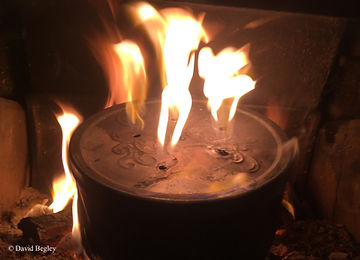Why bake charcoal?

Children's charcoal drawing exercise © David Begley 2021
charcoal for Children
Capturing children’s attention is easy. Holding it has become more challenging over the past few years. I’ve seen this through working in schools. But give a child a stick of charcoal and step back. See what happens. The child quickly becomes absorbed. Offer a bone to draw – evidence that a creature has lived, walked, swum, eaten, died – and children flourish. Give them permission to get their hands (and faces) dirty. Make them laugh and squawk. Allow, encourage this release. Teach them that drawing is a language of its own: a child can communicate ‘fish’ anywhere in the world by drawing a picture of it. Try this yourself, have fun. Speak to your children in grunts, in gobbledegook, through a foreign language - while drawing simple motifs for them to see. Ask them to guess the subject as it appears: eye, star, tree, butterfly, cat . . .
When children draw, notice how they draw, and foster their unique abilities. In doing so witness their imaginations, motivation, confidence, creative thinking and their learning soar. Confidence creates enthusiasm. This spills into other subjects. Make connections: bring visual art into maths, geography, history etc and vice versa. Ask the children to show each other their pictures. To speak of what they like in other children's pictures, to interpret them, and praise them. They learn so much and quickly from each other.

Driftwood © David Begley 2021
Drawing (and art) is not about colouring-in. Nor is it about occupying a child. Fine motor skills can be developed with the crudest of materials – a chunk of burnt stick. Through charcoal drawing children learn about light and shade (tone), line, shape, volume, pattern, texture, composition, narrative, they develop their looking, seeing and perception through observation and imagination.
Charcoal is a versatile medium, easily adjusted, and can be cleaned up quickly at the end of a workshop. It can be used to create animations. Children love to see their drawings come to life. Drawings can also inspire creative writing.
The history of charcoal use is fascinating: in cave drawing, for heating and cooking, smoking fish, smelting, water filtration, make-up, toothpaste, as a digestion aid, odour eating, as a slug repellant, and as a drawing tool throughout art history.

Collier's tools' © David Begley 2021
Explain to children the transformation from stick to char. If you’re lucky enough to live by the sea, take them there and gather driftwood. Face the sea. Draw the sea. Draw sea birds. Record the sound of the sea. Invent sea monsters. Draw rocks. Collect seaweed and seashells, build a raft. Captivate your children’s imaginations. Bake your own charcoal - it’s easy! Show children how – with adult supervision – they can make their own. Notice how driftwood charcoal is blacker, softer, richer and imbued with salty mystery compared to willow, ivy, vine and other traditional charcoals.

Drawing exercise for ages 8 - 12 © David Begley 2021
Making charcoal it is cheaper than buying it. It's sustainable. Home baked charcoal gives you a range of marks, varied hues of black and teaches you an understanding of cold and warm tone. Making charcoal is heart-warming. Whilst gathering wood you come to know your material and bring this to the paper.
Willow and alder give silver black in even tones. It erases easily, sits on the page, lifts with a feather. Harvest it in winter when the sap is low. Strip the bark and leave to dry before baking. Ivy shrinks in the cooking, its bark scratches. For ivy, always use dead wood. The char leans slightly to blue and tends to be brittle, be gentle with it. Vine is harder and sinewy, and gives a dark grey line, is more difficult to rub out and it can tear the page. Bramble is a lovely charcoal. Wearing a leather glove to strip the thorns.

Drawing from 'Breathe' animation, driftwood charcoal © David Begley
For tone and charcoal drawing in general, I love the deep velvet warmth of driftwood. Its black is pitch, the handling softer, its stain fuses with the paper, the colour is richer and more variable than its dry land comparisons – perhaps this is the salt at work.

Homebaked driftwood charcoal © David Begley 2021
I love the process of finding, gathering, burning sea sticks. Watching the flames, smelling the wood smoke, harvesting from the sea, the thought of the journey the timbers have made. Blocks, knots and coiling shapes, exotics with heads and tails, images and stories in themselves. Some sticks so beautiful it’s a shame to bake them.
Driftwood charcoal releases a scent of sea char when you draw with it. The longer it’s baked, the darker and softer the mark. Lesser baked sticks give browns similar to raw umber. Because of its warmth, driftwood is compatible with an under-drawing of burnt cork.
To bake charcoal, wrap dry sticks twice in tinfoil. Make sure oxygen can’t get to the sticks. Using tongs, place wrapped sticks on the embers of a fire and leave to bake overnight. When cooled, remove from tinfoil in the morning.
© David Begley 2021
For information on drawing workshops, teaching resources, tutorials or mentoring write to David at
davidbegleyartist@gmail.com
